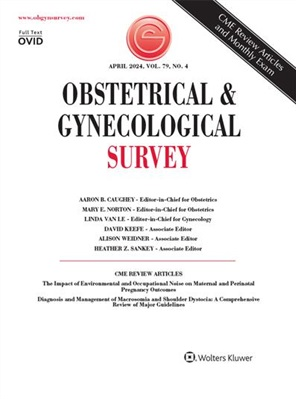An Update on Human Papillomavirus Vaccination in the United States
IF 4.3
4区 医学
Q1 OBSTETRICS & GYNECOLOGY
引用次数: 0
Abstract
ABSTRACT Human papillomavirus (HPV) is the most common sexually transmitted infection in the United States in adults, and although most cases are transient, 10%–20% of infections can persist and progress to various forms of cancer. The HPV vaccine prevents more than 90% of HPV infections and HPV-associated cancers. The vaccine is most effective at preventing all types of HPV-related dysplasia in patients with no prior exposure to HPV. Reasons for decreased compliance include parent-specific factors such as education, safety concerns, absence of professional recommendation, and apprehension about supporting sexual behavior, whereas professional-level barriers include lack of time to discuss vaccination, knowledge gaps, vaccine access, and financial concerns. This clinical expert series highlights the evidence supporting the HPV vaccine as a safe and effective way to prevent cervical cancer. Most HPV infections are acquired in individuals aged 14–24 years with increasing prevalence with each year. Shared decision-making should be used for patients aged 27–45 years, in whom the vaccine has been demonstrated to be safe and effective, but the population advantage of vaccination is expected to be limited. Unvaccinated health care workers exposed to the virus in their practices should be vaccinated between the ages of 27 and 45 years. A previous HPV infection should not be a reason to not receive the vaccine, and it is not necessary to screen individual patients before vaccination. The vaccine is efficacious against other HPV types regardless of which HPV strain an individual may be positive for at the time of vaccination. Regarding women with HPV-related dysplasia such as high-grade squamous intraepithelial lesions that undergo excisional procedures, up to 15% will experience persistent or recurrent disease, and these women are at higher risk of developing a new HPV-associated lesion. Therefore, vaccination may provide a significant reduction in future disease in this patient population. The World Health Organization Strategic Advisory Group of Experts on Immunization recently evaluated the current scheduling regimens for the HPV vaccine and concluded that a single dose may provide enough protection in individuals younger than age 21; however, the Centers for Disease Control and Prevention is yet to comment. An ongoing large randomized, controlled, double-blinded, noninferiority trial (ESCUDDO) is currently evaluating a single-dose versus 2-dose regimen that will help elucidate whether vaccine scheduling in the United States may change to a single-dose paradigm. The strongest predictor of vaccine uptake is health care professional recommendation, and patients with prior infection or excision should still be offered the vaccine. Finally, although vaccination national guidelines are in place for individuals aged 9–26 years, certain patient populations older than 26 years may benefit from the vaccine.美国人乳头瘤病毒疫苗接种的最新进展
人乳头瘤病毒(HPV)是美国成年人中最常见的性传播感染,尽管大多数病例是短暂的,但10%-20%的感染可以持续并发展为各种形式的癌症。HPV疫苗可以预防90%以上的HPV感染和HPV相关的癌症。该疫苗在预防未接触过HPV的患者发生所有类型的HPV相关发育不良方面最为有效。依从性下降的原因包括家长特定因素,如教育、安全问题、缺乏专业建议和对支持性行为的担忧,而专业层面的障碍包括缺乏时间讨论疫苗接种、知识差距、疫苗获取和财务问题。本临床专家系列强调了支持HPV疫苗是一种安全有效的预防宫颈癌的方法的证据。大多数人乳头瘤病毒感染发生在14-24岁的人群中,患病率每年都在增加。对于27-45岁的患者,应采用共同决策,疫苗已被证明是安全有效的,但预计疫苗接种的人群优势有限。未接种疫苗的卫生保健工作者应在27岁至45岁之间接种疫苗。以前的HPV感染不应该成为不接种疫苗的理由,在接种疫苗之前没有必要对个别患者进行筛查。该疫苗对其他HPV类型有效,无论个体在接种疫苗时可能对哪种HPV毒株呈阳性。对于患有hpv相关发育不良的妇女,如接受切除手术的高级别鳞状上皮内病变,高达15%的妇女将经历持续或复发性疾病,这些妇女发展为新的hpv相关病变的风险更高。因此,疫苗接种可能会显著减少这一患者群体未来的疾病。世界卫生组织免疫战略咨询专家组最近评估了目前的人乳头瘤病毒疫苗接种方案,并得出结论认为,单剂疫苗可为21岁以下的个人提供足够的保护;然而,美国疾病控制与预防中心尚未对此发表评论。一项正在进行的大型随机、对照、双盲、非劣效性试验(ESCUDDO)目前正在评估单剂量与2剂量方案,这将有助于阐明美国的疫苗计划是否可能改为单剂量方案。疫苗接种的最强预测因子是卫生保健专业人员的建议,既往感染或切除的患者仍应提供疫苗。最后,尽管针对9-26岁的个体制定了疫苗接种国家指南,但某些26岁以上的患者群体可能受益于疫苗。
本文章由计算机程序翻译,如有差异,请以英文原文为准。
求助全文
约1分钟内获得全文
求助全文
来源期刊
CiteScore
2.70
自引率
3.20%
发文量
245
审稿时长
>12 weeks
期刊介绍:
Each monthly issue of Obstetrical & Gynecological Survey presents summaries of the most timely and clinically relevant research being published worldwide. These concise, easy-to-read summaries provide expert insight into how to apply the latest research to patient care. The accompanying editorial commentary puts the studies into perspective and supplies authoritative guidance. The result is a valuable, time-saving resource for busy clinicians.

 求助内容:
求助内容: 应助结果提醒方式:
应助结果提醒方式:


